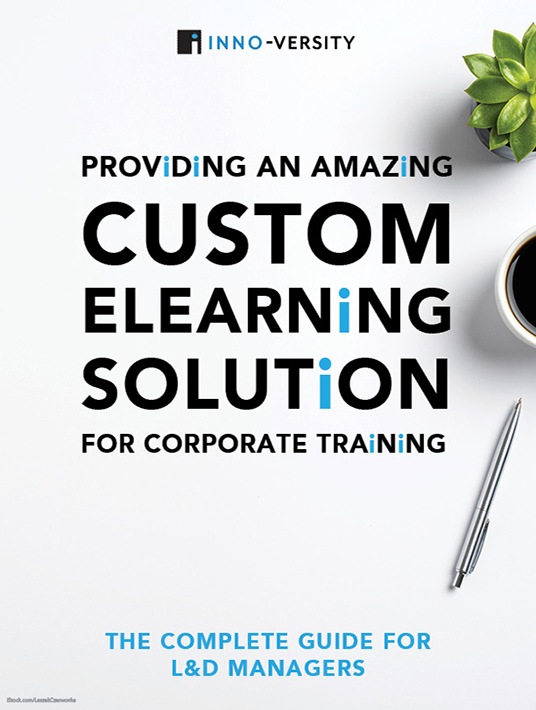Custom eLearning Solutions: The Right Time To Invest
For a lot of companies, the decision to invest in custom digital learning is risky. Ines, Director of Learning and Development, understood that risk. Her company hires 3,000 seasonal employees each year and Instructor-Led Training was no longer viable. Costs for hotels, travel, venues, staff, and per diems were consuming significant resources that would be better used in other places. The C-Suite, while not familiar with the intricacies of digital learning, believed there was an opportunity to maintain the quality of their training and greatly reduce the annual cost. Some of Ines’s company leaders believed. Others had serious doubts.

Making the investment in custom eLearning, of course, isn’t the only option. Ines could have looked for off-the-shelf software training that could have been combined with an Instructor-Led component. It likely would have been more efficient and required fewer classroom hours. But there was more to consider.Branding mattered to her company. Efficiency was not the only concern. Since learners would be customer-facing, they needed to become brand ambassadors as well as master the material in a short period of time. Ines needed the company’s brand to shine through, and she needed to ensure a nervous C-Suite that her custom eLearning solution was the right one. The stakes were high.
So how do you know when it is time to invest in custom eLearning? Maybe the question is better asked in reverse: when doesn’t it make sense to invest in custom digital learning? Companies usually don’t make the investment in custom digital learning for material that is low-priority, generic or focused mostly on compliance and checking a box that training has been completed. Smaller companies can accomplish this type of training with classroom presentations, often using PowerPoint slides from 2002, followed by a written test. The test gets filed, the team member is compliant, and the company can say it provided the training as mandated. Larger companies, or those with a geographically diverse workforce, can easily and inexpensively obtain courses on topics like blood-borne pathogens or lockout/tagout, which can be delivered digitally with records being stored in an LMS.
For more complex learning, a more complex solution is needed. Moving past generic compliance will require mapping learning objectives and determining not only whether or not digital learning is the best choice, but actually which form of digital learning will work best. Blended learning, with some ILT and some digital, may make the most sense. Digital scenarios, micro-learning or augmented reality might be the right digital tools. Gamification may also play a role. It isn’t as simple as merely deciding between custom digital learning and something else. The audience will determine a lot about the format. For instance, millennials learn differently than baby boomers. Are there language barriers to consider? Will the learning be global? Does localization matter? What is the education level of the learners?
It’s no secret that eLearning is cost-effective. From regained employee productivity to decreased instruction expenses, the cost savings alone make the choice between eLearning and pure ILT a no-brainer. So let’s concede that digital learning wins the budget discussion. When it comes to learning, however, the cost isn’t the only consideration. Let’s take a look at some of the value-drivers of eLearning beyond cost:
1. Customizability
When you choose to create custom digital learning, your own materials are used to create engaging learning that can be accessed at any time, meaning several things:
- Your employees are learning the right information for their specific roles, not generic information that might be inaccurate for your company.
- You can print far fewer–if any–physical materials like manuals or binders, saving on material costs.
- Modules can be built with your industry, company, and learners in mind, making it more effective and increasing your ROL (Return on Learning).
In addition, customizing eLearning to your organization means you can keep branding and message consistent with other aspects of your employee experience. Your employees should know exactly how to represent their company to friends and customers alike, and your training materials should reinforce the image you are conveying to the world. After all, if your employees don’t know your brand inside and out, how do you expect consumers to ever care?
2. Flexibility
Customizability is great and all, but the idea of such an individualized module probably calls to mind two things: price and rigidity. What happens when you need to add more materials, or you want to tweak your brand messaging, or some part of it isn’t working the way you expected? Is it worth making the investment if you’re just going to outgrow it? Thankfully, eLearning modules are far from static, and the flexibility a custom module affords you is worth, well, a lot more than its weight in gold. (Fun fact: data does actually weigh something!) Modules built for your organization can be translated, added to, changed, and updated without having to go back to the drawing board, without much added time and expense. In this way, you can extend the value of your investment for years. eLearning is also flexible on the learner’s side. Cloud-based eLearning modules can be accessed from practically any device at any time, giving employees the ability to learn when it’s convenient and without disrupting productivity. They can also use eLearning modules to quickly access information exactly when they need an answer to a question.
3. Trackability
One of the common arguments against eLearning is the loss of accountability and personal interaction that comes with ILT. There are two things wrong with this argument: first, ILT and eLearning are by no means mutually exclusive; and second, a well-designed eLearning module should offer greater accountability and insight into an individual’s learning than an instructor could. Like any method of delivery, eLearning does not exist in an information vacuum. We are constantly learning from each other, from our environments, and from our own initiatives and interests. Adaptable eLearning modules can allow learners to test out of content that they already know or go further into a topic that’s particularly relevant to them. Management and L&D can track their efforts, follow up on areas where they’re having trouble, and factor their learning into their performance—and with the data to back it up, it’s a pretty sure thing that you’re going to get better insights than an instructor alone could offer.
4. Scalability
The scalability of eLearning modules is related to its flexibility, but in terms of value, it offers a look into the ROI that’s a little easier to calculate. Say you create a module for your US-based office of 1,000 employees. Then, your company grows and adds another thousand. Or, you expand to another location with 500 more. Or, you start to look overseas and add another 1,500 who conduct business in another language. With classroom-style delivery, you’re looking at a logistical and financial nightmare. With custom eLearning, you can deliver consistent information in a consistent manner, making employee development seamless as your organization grows. From a numbers standpoint alone, that’s a tremendous long-term value. Let’s go back to Ines’s story. When the first completed modules were presented to the HR team, Ines received a standing ovation (true story). She made the right choice. She hit her KPIs, saved her company a lot of money, and convinced some C-Suite skeptics that, in the right circumstances with clear objectives, custom digital learning worked best.
When it comes down to the value of eLearning, it’s not all about the cost. Its true value goes far beyond the numbers to the ability to develop a culture of learning within your organization with the power to help everyone succeed. Are you an L&D professional looking forward to adopting great corporate training practices which employees will find more than useful? Download our eBook Providing An Amazing Custom eLearning Solution For Corporate Training to discover when companies should invest in custom eLearning, the factors to determine the appropriate level of interactivity needed, the stages of the custom eLearning development process, and much more...
If you require to learn more in-depth about the importance of custom eLearning development, you should check the webinar Developing Custom eLearning For Corporate Training. This webinar will be led by experts who have managed some of the most significant eLearning projects in the world.










